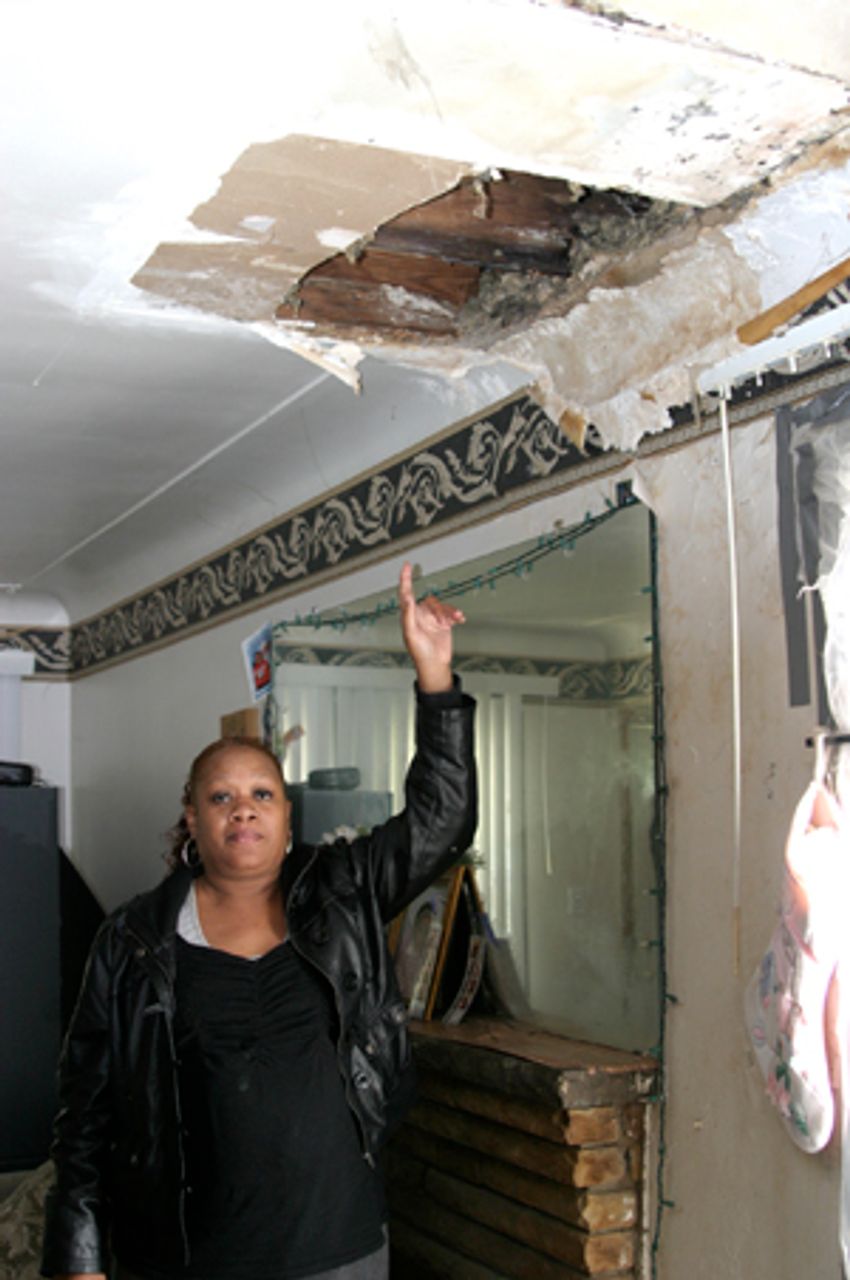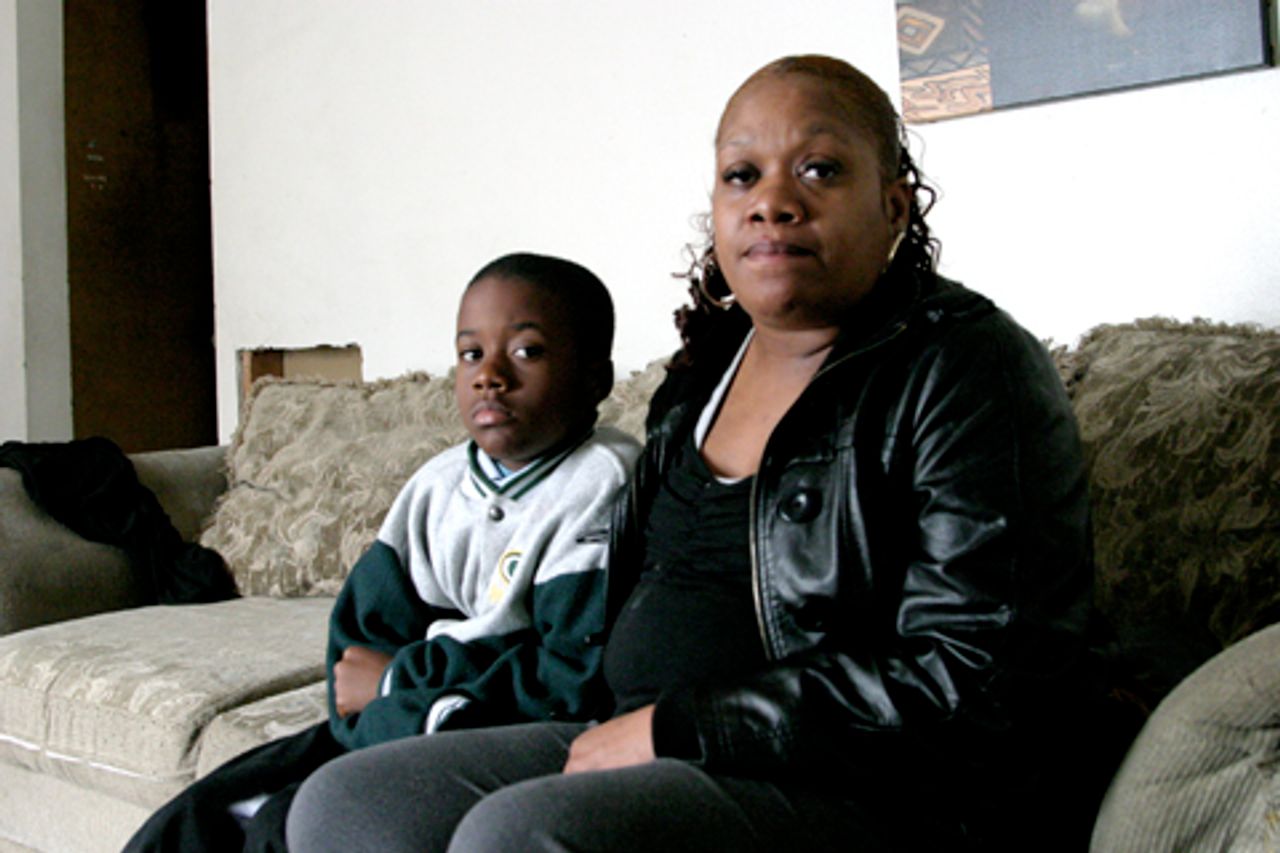On October 4, a federal judge issued a temporary injunction against the implementation of cuts to Michigan’s welfare system that would eliminate all cash assistance to 41,000 residents, including 29,700 children. The decision is expected to give poor recipients, at most, another month of assistance. The cuts were scheduled to go into effect on October 1.
 Welfare recipient Charlotte Watson pointing to hole in the ceiling where rain pours into her Detroit home
Welfare recipient Charlotte Watson pointing to hole in the ceiling where rain pours into her Detroit homeU.S. District Judge Paul Borman charged that the state government and the Department of Human Services did a poor job of notifying people of the cessation of benefits. Recipients had only been notified on September 11, less than three weeks prior to the termination of benefits.
The ruling does not overrule or permanently halt the decision. It merely delays the measure, instructing the state to send out new notices that include information on the recipients’ appeal rights as well as the reasons for the cuts.
The highly political court decision is an expression of fears in leading circles that the Republican legislature and governor, Rick Snyder, are creating the conditions for a social explosion. The decision follows last week’s protest stunt organized by Democratic officials including Jesse Jackson, US Congressman John Conyers and Michigan Congressman Gary Peters calling attention to the October 1 cutoff.
Gilda Jacobs, president and CEO of the Michigan League for Human Services (MLHS), welcomed the decision but admitted that the ruling is at best a small reprieve. “It does give people more time to prepare,” stated Jacobs to the media. “If we are looking to get policy change, this is not it. It’s just giving people some breathing room.”
Spokesperson for Governor Snyder, Sara Wurfel, said the administration was “happy” to send out another notice. In an Orwellian rejoinder, Wurfel said the government would continue its efforts “to make sure families are connected to the resources necessary to achieve independence.”
The four-year limit on cash assistance was originally implemented by the Democratic Granholm administration, but additional restrictions were imposed by the Republican legislature this year.
The WSWS spoke to Charlotte Watson of Detroit, 45, a mother of four, who had been notified that she would lose her cash benefit. Like many other recipients, Charlotte works. But her $7.40 an hour, part-time at job at Subway restaurant pays so poorly that she qualified for the state’s meager program. It provided only $179 every two weeks and barely allowed to her make the $300 monthly rent.
 Charlotte and youngest son Gabriel, 9
Charlotte and youngest son Gabriel, 9 With the still-pending threat of termination of cash benefits, Charlotte faces a very bleak situation. She recounted the discussion with her caseworker, “How can I live on this, I can’t even live with that [the small assistance]? I still have four children to take care of.” The Department of Human Services (DHS) told her to apply for rental assistance. However, in Michigan these benefits are one-time only and very short term.
“After 3 months, I’m back to square one, the same position,” Charlotte explained. “It’s getting harder and harder by the day. I feel like I am about to lose it altogether.
“At this point, I am thinking every day on where me and my children are going to live,” she said.
“The biggest problem is there’s no work out there. I’ve tried everywhere. There really is nothing.”
Charlotte explained that her work hours varied widely from week to week. “Sometimes I get 15 hours, sometimes 25. As you can see, I cannot live on this wage. How can you support your family like this?”
 Charlotte’s neighborhood on the west side of Detroit
Charlotte’s neighborhood on the west side of Detroit“I am very worried. Winter is coming. I don’t know what I am going to do about having utilities in my home.”
MLHS spokesperson Judy Putnam told the WSWS that Charlotte’s story is all too common. “The DHS has said it will pay for rental assistance for 2-3 months for a family that is looking for work. But we know that unemployment is 11.2 percent, and the cuts are taking place in very high unemployment, very high poverty areas. Unless a miracle happens by January we will just be pushing them out in the street in the dead of winter.”
“This is a high poverty period,” Putnam said, “and the jobs really are not there.” She also emphasized that in Detroit there is a very long waiting period for subsidized housing.
“And even if people are able to get by,” Putnam asked, “how are they going to pay their utilities?” Living without utilities is a major cause of house fires and has led to the deaths of dozens of Detroiters over the past few years. Charlotte has already been living for two months without gas or electricity in her Westside home. Originally, she said the utilities were in the landlord’s name. However, when the landlord was shut off, Charlotte also lost power.
At that point, Charlotte tried to get the utilities in her own name, but she had a back bill for over $3,647 for both gas and electricity from her previous home. “I went to DHS for help. They said they could only assist with $850, not even half.
“I went around everywhere possible, I’ve contacted everyone I possibly could for assistance and everyone says they do not have any money. I don’t know where else to turn.”
October 1 usually marks the date when social services agencies in Detroit can provide utility assistance. However, this year all funds from the Low Income Energy Efficiency Fund (LIEEF) are tied up in court. These funds, collected from utility customers, are held by the utility companies and typically disbursed to agencies such as the Heat and Warmth Fund. This year, however, ABATE, a Michigan “trade association for large industrial customers”, e.g. the auto industry, sued to prevent the LIEFF from distributing its funding. A court decision is pending; meanwhile all potential assistance is frozen. Last year more than 95,000 families received funds through LIEFF. Additionally, the Obama Administration has proposed a 50% cut in fiscal 2012 for the Low Income Home Energy Assistance program.
These ruthless measures are leaving families literally with no place to go. “At night we are staying with friends and family members—whoever I can to put us up,” continued Charlotte. “My kids all go to school in the neighborhood, but it has been extremely difficult without any utilities.
“With four children, where are you going to live with someone when they are all in the same position as you are?” Charlotte asked. When she does get a chance to stay with someone, she said, the entire family, herself included, must sleep on the floor. “Wherever you go, people want money to help them to pay for their own rent and utilities. But it is impossible for me to pay the utilities in my own house and to pay someone else to stay with them as well.”
“Almost everybody I know has two to three families in one house. We are talking about at least 8-9 people in a house. “
“For kids, this is very difficult—moving around from place to place and sleeping on floors. People will say to me, ‘This is my place. You have to adhere to my rules.’ I get tired of hearing that. We need our own place. I have a 15-year-old son at Cody High School who is at that point where he needs his own space. He is constantly agitated.”
Explaining the poor conditions in the home, Charlotte pointed to the ceiling. “Here we have a leaky ceiling. When it rains outside, it is pouring in here and in the kitchen,” she said pointing to the gaping holes in the roof. “The landlord won’t repair anything. For $300, he tells me, it is an as-is house.”
“I’ve been at this house since January 2010,” continued Charlotte. “Before that I lived in a house that was owned by my family. But because of the poor insulation, the electricity bill accumulated in the winter.” She explained that the gas and electricity had then been cut off there since 2008. “I lived without utilities there for a year and a half.”
“I am desperately trying to get my electricity cut on before the winter hits. I don’t want my kids traveling here and there in the wintertime. I have beds here but they can’t stay here.”
Asked if she used a food bank, Charlotte said that she could not because she didn’t have a car. “You have to ask or pay someone to get around and do anything. I don’t have the money. They are making it harder and harder for you and your children to live. I am tired of living like this.”
Putnam observed, “They are cutting unemployment benefits from 26 weeks to 20; they are applying lifetime limits in the worst economy we have known in our lifetime; and they are now limiting food assistance by disqualifying people who have more than $15,000 in assets, including a car.”
She pointed out that 48 states exempt at least one vehicle, but in Michigan where public transportation is almost nonexistent and there is the highest unemployment rate in the country, the state disqualifies food stamp applicants who own a modest car.
Explaining that the welfare cuts, when implemented, will accumulate each month, Putnam estimated that 14,000 families will be affected by September 2012. The new law counts many more months against a family’s lifetime limit than previous legislation, so that it combines both the 60-month federal limit imposed by the Clinton administration together with the new state policy, and ends up dramatically reducing eligibility.
“It really feels like the victims of the recession are being blamed for the bad economy,” concluded Putnam.
The author also recommends:
Michigan child poverty surges
[6 October 2011]
30,000 children face destitution from welfare cut in Michigan
[16 September 2011]
